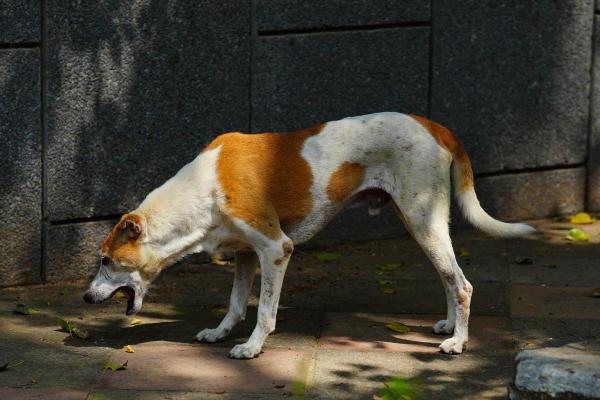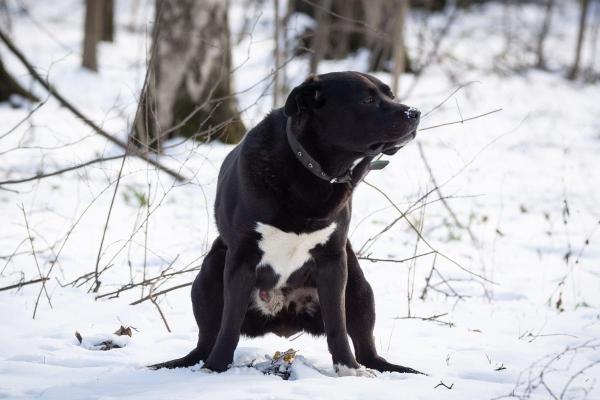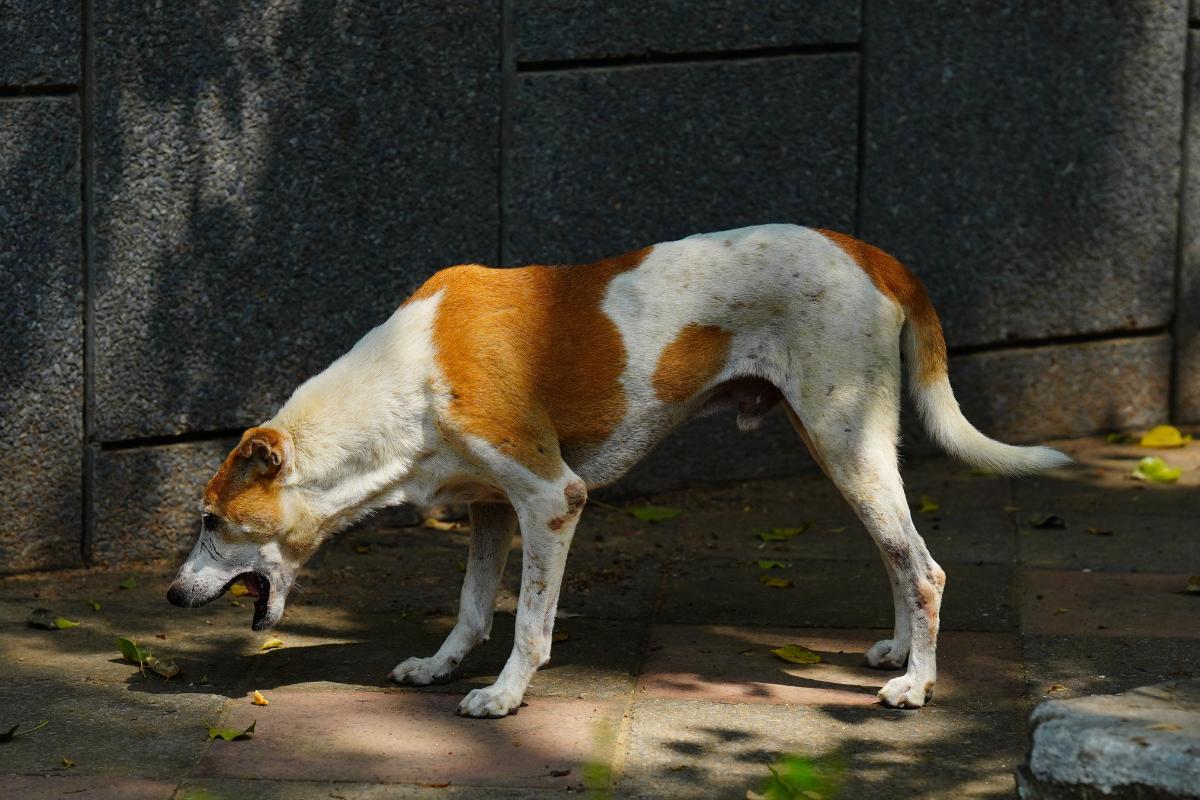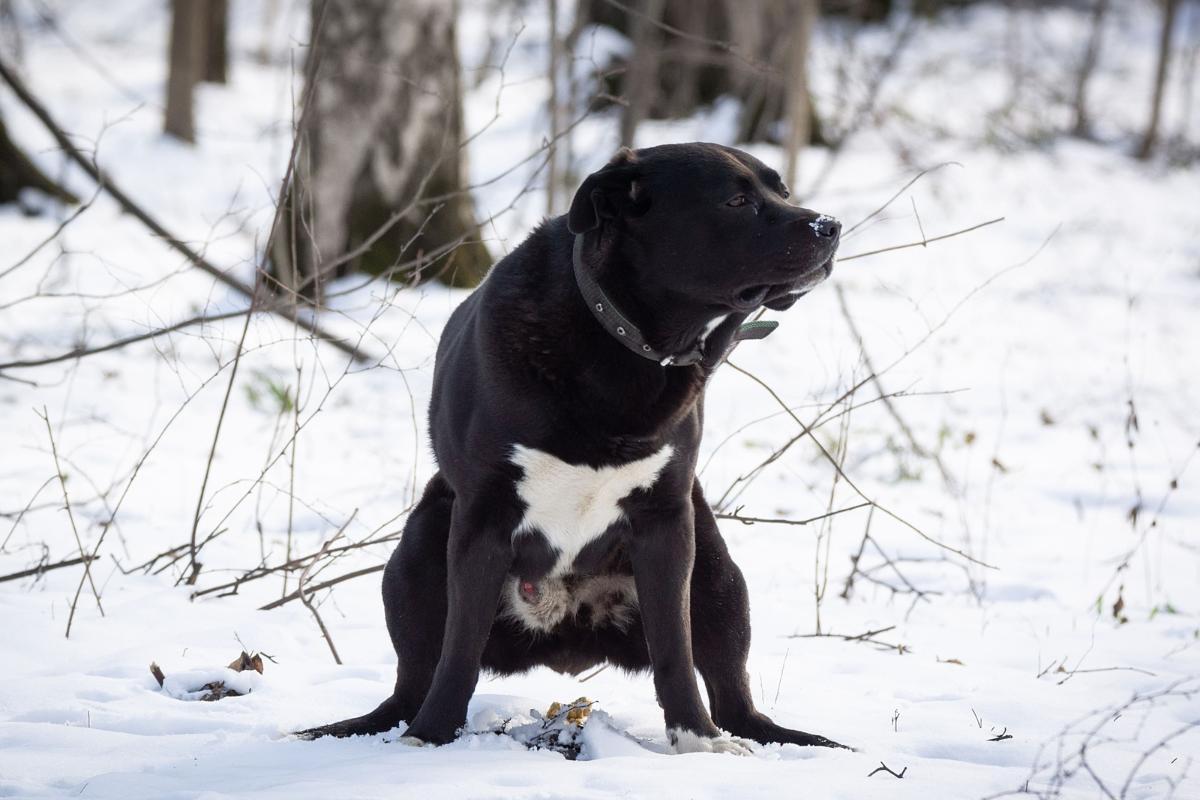Bloody Mucus in My Dog's Stool - Causes and Treatment



See files for Dogs
Bloody mucus in a dog's stool can be accompanied by other symptoms which imply the dog is gravely ill. If this is the case, you will need to take them to a veterinarian immediately. Clinical signs such as lethargy, loss of appetite and vomiting imply the dog is in serious trouble. This means we can be quite confused when there is blood and mucus in a dog's poop, but they are acting normal. Generally speaking, if we see fresh blood and mucus in the dog's stool, it means the problem originates in the large intestine closer to the anus. If it occurs further up the gastrointestinal tract, the blood will have been at least partially digested and darken the stool.
At AnimalWised, we find out why there is blood and mucus in my dog's stool. We look at the possible causes and treatment of this problem to know what we might expect.
Parasitic colitis
A common disease in European and American dogs is parasitic colitis caused by the whipworm species Trichuris Vulpis. This is a parasite that causes our dogs to defecate mucus and blood in their stool. This parasite invades the proximal colon, inflaming and causing damage to its mucosa. In turn, this causes an infestation in our dog that has intermittent diarrhea as one of its main symptoms.
In addition to bloody mucus in the dog's stool, whipworm parasitosis might produce the following symptoms:
- Anemia
- Hypoalbuminemia
- Eosinophilia
It is diagnosed by parasitological diagnostic tests detecting eggs in feces or by colonoscopy. When treating this parasitic inflammation of the dog's colon, an antiparasitic treatment such as fenbendazole for dogs should be administered. This must be repeated after 3 months due to the prepatent period of the parasite. This is the time between the initial infection of the host and the first observable symptoms of the parasite.
In cats, the protozoan parasite Tritrichomonas foetus is a frequent cause of parasitic colitis. In dogs, parasitic colitis can also occur due to Pentatrichomonas Hominis. This must be treated with metronidazole for dogs due to its antiprotozoal potential. It is important to note that dogs affected by this type of parasitic colitis usually have bloody diarrhea which is not caused directly by the protozoan, despite a positive diagnosis of this parasite.
Learn more about the reasons why a dog has bright red blood in their stool.
Bacterial colitis
A dog with blood and mucus in their stool may also have these symptoms due to a bacterial infection. Various types of bacteria can cause inflammation of the colon. This inflammation damages the tissue and can lead to bleeding in the lower part of the GI tract, resulting in blood and mucus in their poop. Some of the most common bacteria species that cause colitis in dogs are the following:
- Salmonella spp.
- Campylobacter jejuni
- Clostridium perfringens
- Yersinia enterocolitica
Salmonella spp.
This gram-negative bacillus-type bacteria is transmitted by the feco-oral route through the ingestion of contaminated water or food. It most frequently affects young dogs and dogs from kennels. This is due to the immaturity of their immune system and the spread of infection due to close contact, respectively. This infection causes:
- Acute mucosal diarrhea with vomiting
- Dehydration
- Anorexia
- Fever
- Urgent need to defecate
The majority of dogs that pass stools with blood and mucus due to bacterial colitis recover after 3-4 weeks without treatment. The use of antibiotics is only indicated when there are signs of clinical endotoxemia or bacteremia. The risk of alteration of the local microbial ecosystem is usually higher than the benefit of the treatment.
Campylobacter jejuni
If we find blood in the dog's feces with mucus, it may be due to Campylobacter jejuni. If this is the case, only the veterinarian will be able to confirm infection. This gram-negative bacteria is an important pathogen in veterinary and human medicine, transmitted by the feco-oral route. In addition toa dog having bloody diarrhea, the dog might have fever and lethargy . It is treated with antibiotics, with erythromycin or enrofloxacin being the first choice.
Clostridium perfringens
This gram-positive obligate anaerobe belongs to the gut flora of cats and dogs. In normal amounts, it does not cause a problem. Only when there is an overproliferation of this bacteria are symptoms generated. The diarrhea resulting form this problem often contains blood and mucus. It is treated with antibiotics such as amoxicillin, oral tolosin or metronidazole. High-fiber diets can also create conditions that are not favorable for the germination of the spores of this microorganism.
Yersinia enterocolitica
Infectious colitis can also be caused by Yersinia enterocolitica, a facultative anaerobic bacteria. It does not usually produce infectious colitis in dogs directly, but but can lead to a dog with acute or chronic diarrhea with blood and mucus. Treatment should be with tetracyclines, cephalosporins or trimethoprim/sulfonamide.
Learn more about another reason why dogs might have diarrhea with our article on intestinal malabsorption in dogs.

Fungal colitis
Another reason why dogs might have blood and mucus in their poop is due to fungal infection. Fungi from the genus Histoplasma are common, a dimorphic fungal organism that proliferates in the United States .
Fungal infections are transmitted by environmental spores. Although most associated with respiratory distress in dogs, they can spread to the gastrointestinal tract. They produce an extensive granulomatous reaction of the tissue in the large intestine, producing large intestine diarrhea with fresh blood, mucus, fever and weight loss. This fungal colitis in dogs is treated with itraconazole alone or in combination with amphotericin B.
The quality and consistency of a dog's stool can help us to point to the underlying cause. Learn more about different variations by looking at the types of diarrhea in dogs.
Inflammatory bowel disease
Both the small intestine and the large intestine can also suffer from inflammatory diseases characterized by the infiltration of inflammatory cells in its tract. As a general description, this is referred to as inflammatory bowel (IBD) disease in dogs. The three main types of large intestine inflammation that explain why there are bloody stools in dogs and mucus are the following:
- Lymphocytic-plasmacytic colitis: it is the most common form of chronic colitis in dogs, manifested with cyclic symptoms of bloody stools in dogs and mucus. They also experience, an urgency to defecate or rectal tenesmus, i.e. feeling the need to defecate even with an empty bowel. The affected mucosa of the large intestine is fragile, with loss of vascularization of the submucosa, erosions and increased granularity.
- Eosinophilic colitis: this inflammatory disease of the colon can occur as an allergy to parasitic or dietary antigens. It consists of a diffuse infiltration of eosinophils in the colonic mucosa, in addition to being more friable and ulcerated compared to the previous type of canine colitis.
- Chronic histiocytic ulcerative colitis: this is the least common type of IBD and affected dogs exhibit hematochezia, tenesmus and intractable diarrhea of the large intestine. We can also see loss of appetite and lethargy. This type of colitis is most frequently diagnosed in Boxer dogs under one year old. An infiltrate of histiocytes occurs in the colonic mucosa. In this case, antibiotics such as enrofloxacin for dogs seem more useful compared to the immunosuppressants used in the previous two.
Learn about a related disorder in dogs with our article on intestinal obstruction in dogs.
Intestinal tumors
Tumors in dogs can be malignant or benign, but either can produce blood and mucus in the dog's stool. The most common tumor is adenocarcinoma, followed by lymphosarcoma and leiomyosarcoma. The latter is often located in the cecum, although the majority of large intestinal neoplasms in dogs are located in the descending colon and rectum.
When a dog has a malignant tumor of the colon, a palpable abdominal mass, mesenteric lymphadenopathy, excessive granularity of the mucosa and dyschezia (difficulty defecating) can be observed. To assess the stage of the disease, imaging tests and a colonoscopy with mucosal biopsy will be required for definitive diagnosis.
In focal adenocarcinomas and leiomyosarcomas, the treatment of choice is surgical resection of the tumor. Diffuse lymphosarcomas are preferably treated with multiple chemotherapy.
Use our article on the different types of tumors in dogs to learn about this subject.

Irritable bowel syndrome
Irritable bowel syndrome is a rare disease that appears more frequently in large breed dogs. It is characterized as a non-inflammatory pathology associated with various issues, including:
- Abnormal myoelectric function of the colon
- Stress
- Food allergies or intolerances
- Lack of fiber in the diet
- Changes in the neurochemical or neuronal regulation of colon function
Affected dogs will present clinical signs of chronic, intermittent large intestinal diarrhea. Blood and mucus in the stool, tenesmus and dyschezia are common.
To treat this pathology, we must reduce stress in our dogs. This means assessing their environment and providing additional support. Ensure a sufficient supply of fiber in the diet to correct abnormal motility patterns. If dogs that pass stools with blood and mucus do not respond to this dietary management, they can be use drugs that modify digestive motility, such as loperamide.

This article is purely informative. AnimalWised does not have the authority to prescribe any veterinary treatment or create a diagnosis. We invite you to take your pet to the veterinarian if they are suffering from any condition or pain.
If you want to read similar articles to Bloody Mucus in My Dog's Stool - Causes and Treatment, we recommend you visit our Intestinal problems category.
- Edward J. Hall, James W. Simpson, David A. Williams. (2009). Manual of Gastroenterology in small animals, 2nd edition. S Editions.







